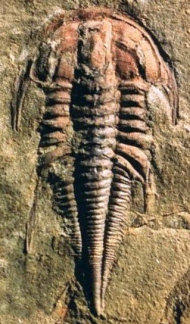Emuelloidea
Appearance
| Emuelloidea Temporal range: late Botomian
| |
|---|---|

| |
| Balcoracania dailyi of the family Emuellidae Lower Cambrian Emu Shale Kangaroo Island, South Australia © Dave Simpson | |
| Scientific classification | |
| Kingdom: | |
| Phylum: | |
| Class: | |
| Order: | |
| Suborder: | |
| Superfamily: | Emuelloidea Pocock, 1970
|
| Families | |
Emuelloidae are a small superfamily of trilobites, a group of extinct marine arthropods, that lived during the late Lower Cambrian (late Botomian) of the East Gondwana supercontinent, in what are today South-Australia and Antarctica. Emuelloidea can be recognized by having a prothorax consisting of 3 or 6 segments, the most backward one of which is carrying very large trailing spines. Behind it is the so-called opistothorax. There are two families, the Emuellidae (with a prothorax of six segments) and the Megapharanaspididae (with a prothorax of three segments).[1]
References
- ^ Paterson, R.J.; Jago, J.B. (2006). "New trilobites from the Lower Cambrian Emu Bay Shale Lagerstätte at Big Gully, Kangaroo Island, South Australia". Memoirs of the Association of Australasian Palaeontologists. 32: 43–57. hdl:1959.14/10651. ISSN 0810-8889.
